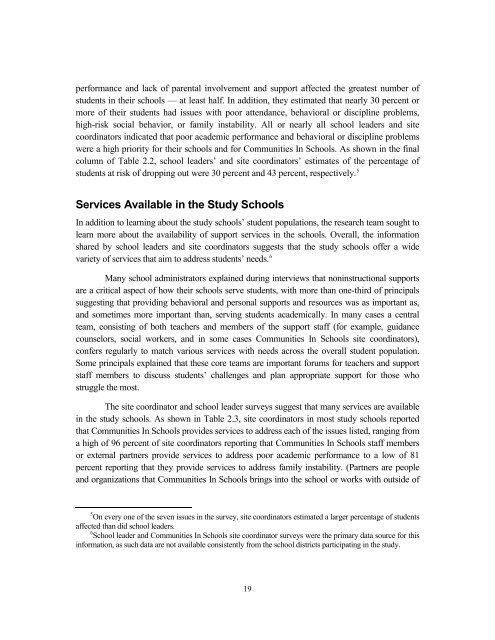NNFGV
NNFGV
NNFGV
You also want an ePaper? Increase the reach of your titles
YUMPU automatically turns print PDFs into web optimized ePapers that Google loves.
performance and lack of parental involvement and support affected the greatest number of<br />
students in their schools — at least half. In addition, they estimated that nearly 30 percent or<br />
more of their students had issues with poor attendance, behavioral or discipline problems,<br />
high-risk social behavior, or family instability. All or nearly all school leaders and site<br />
coordinators indicated that poor academic performance and behavioral or discipline problems<br />
were a high priority for their schools and for Communities In Schools. As shown in the final<br />
column of Table 2.2, school leaders’ and site coordinators’ estimates of the percentage of<br />
students at risk of dropping out were 30 percent and 43 percent, respectively. 5<br />
Services Available in the Study Schools<br />
In addition to learning about the study schools’ student populations, the research team sought to<br />
learn more about the availability of support services in the schools. Overall, the information<br />
shared by school leaders and site coordinators suggests that the study schools offer a wide<br />
variety of services that aim to address students’ needs. 6<br />
Many school administrators explained during interviews that noninstructional supports<br />
are a critical aspect of how their schools serve students, with more than one-third of principals<br />
suggesting that providing behavioral and personal supports and resources was as important as,<br />
and sometimes more important than, serving students academically. In many cases a central<br />
team, consisting of both teachers and members of the support staff (for example, guidance<br />
counselors, social workers, and in some cases Communities In Schools site coordinators),<br />
confers regularly to match various services with needs across the overall student population.<br />
Some principals explained that these core teams are important forums for teachers and support<br />
staff members to discuss students’ challenges and plan appropriate support for those who<br />
struggle the most.<br />
The site coordinator and school leader surveys suggest that many services are available<br />
in the study schools. As shown in Table 2.3, site coordinators in most study schools reported<br />
that Communities In Schools provides services to address each of the issues listed, ranging from<br />
a high of 96 percent of site coordinators reporting that Communities In Schools staff members<br />
or external partners provide services to address poor academic performance to a low of 81<br />
percent reporting that they provide services to address family instability. (Partners are people<br />
and organizations that Communities In Schools brings into the school or works with outside of<br />
5 On every one of the seven issues in the survey, site coordinators estimated a larger percentage of students<br />
affected than did school leaders.<br />
6 School leader and Communities In Schools site coordinator surveys were the primary data source for this<br />
information, as such data are not available consistently from the school districts participating in the study.<br />
19


